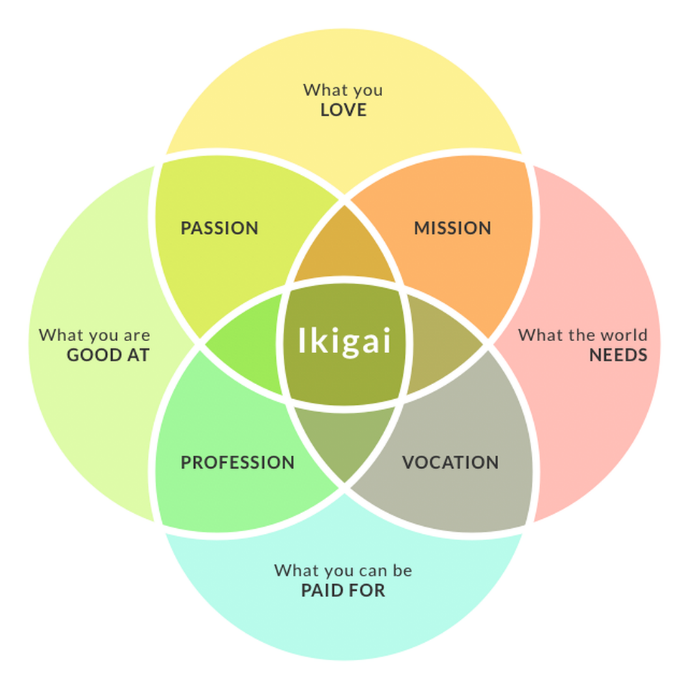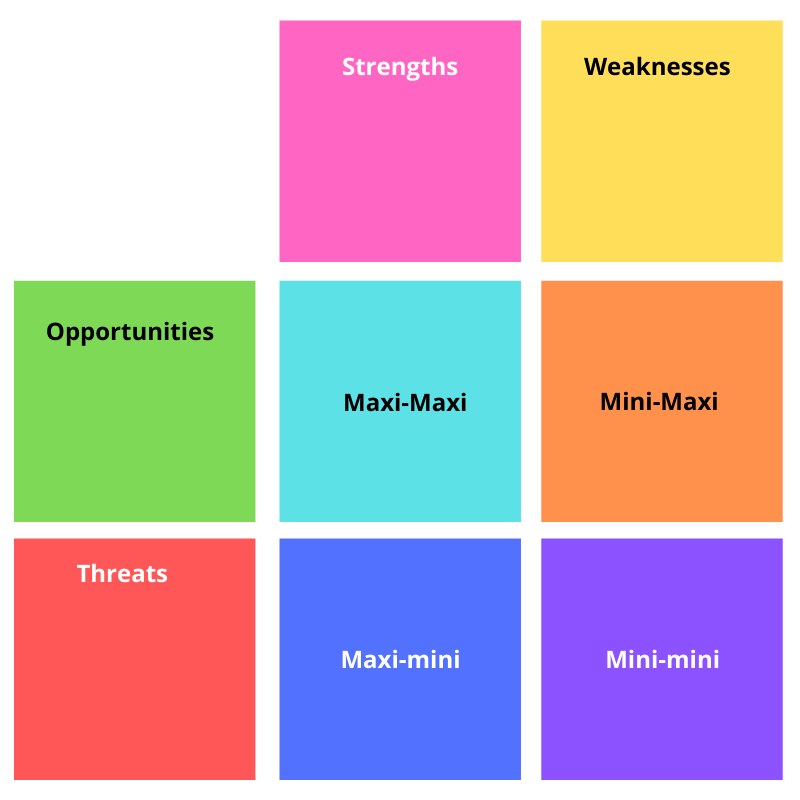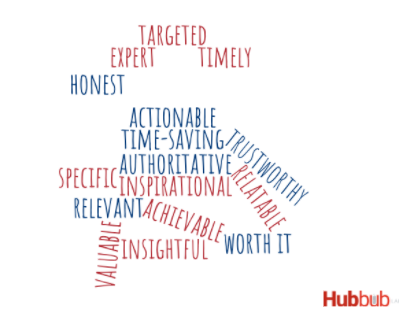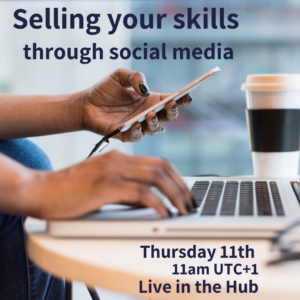George Chilton has an extensive career in ELT, working as a teacher, writer, translator and editor. He’s the co-owner of Hubbub Labs, a company set up in 2017 which offers content marketing support for education businesses. He also co-founded SLB Coop, a teachers’ cooperative based in Barcelona.
He started off the webinar by pointing out that everyone has a unique career path and so no single piece of advice will suit everyone. He shared a great cartoon: Life begins at the end of your comfort zone. Having a strategy that will help you grow as a professional will help you take new steps and we’ll all be pushed out of our comfort zone at some point (take the pandemic for example!).
A lot of the later stages of the talk focus on personal branding. It’s not the nicest of phrases, but it does help you sell what you want to sell. But before you start trying to sell yourself, you need to know who you are and what you want.

Ikigai (7.30)
This concept helps you think about what you want and what you can excel at. It can help you to find a focus and to find a way to move forward.
Five steps to personal branding (9.00)
These are similar steps to business strategy.
- Where am I now in my career?
- Where do I want to be?
- What steps am I going to take to get there?
- How am I going to position myself through content?
- Who can help me and what tools can I use?
It’s good to write a personal statement about who you are and then think about your vision. From there, you can make an action plan about how you’re going to get there – people with a plan tend to achieve their objectives.
Point 4 relates to your personal brand – how are you going to present yourself to the market you’re trying to reach?
And in point 5, never underestimate the people – the old saying “It’s not what you know, it’s who you know” is very true and people who know who you are and what you do can help extend your network and provide you with more opportunities.
TOWS chart (11.45)
This is another tool to help you focus your strategy and become more self-aware.
You need to maximise you opportunities and strengths and minimise or mitigate your weaknesses and threats.
Start by completing the outer boxes (TOWS) and then you can think strategically about your direction by cross-referencing the boxes, e.g. How can you use your strengths to maximise your opportunities? How can you minimise your weaknesses to maximise your opportunities?
It’s good to look at this critically with an accountability partner – our Progress Hangouts are the perfect opportunity for this!

SMART goals (15.45)
We often do these for our lessons, but it’s good to think about them for our own objectives too. With a SMART goal, you can create your action plan and give yourself deadlines to complete the steps you need to. Again, working with an accountability partner is a really good way to keep things moving.
Why brand yourself? (17.00)
Once you know who you are, where you want to go and how you’re going to get there, you need to share this with others – if people don’t know what your goals are, they won’t be able to help you achieve them.
George shared the personal brand of Dror Wayne – he’s young but is good at marketing himself. He created his personal brand to show people what he has to bring to the table, particularly so they wouldn’t judge him on his youth. There’s a great video of him with his multimedia quote of why he created his brand.
Why create content on social media? (21.30)
To position yourself as a professional in the area you want to be in.
- improve visibility
- network with the right people
- build an online portfolio
- learn from others
- stand out from the crowd
- be a ‘go-to’ expert
- build social proof
- discover opportunities
Think about the profile you use – you might want to keep Facebook as your personal space (or create a page for your brand).
When people are looking for people, the people who are most in your mind will spring to mind so posting regularly can really help to improve your visibility…even if it doesn’t seem to have an immediate effect. Social media is also a great way to build an online portfolio – share testimonials from your clients, write articles on LinkedIn, share materials or learning/teaching tips, etc.
Think about your niche – what group of people do you want to talk to?
Social Presence (27.25)
Focussing on LinkedIn as it’s the most-used professional network. Use the header on your profile to show what you do, e.g. your mission statement, your contact details, your skills.
Work on your About section – you have about two lines to sell yourself before the ‘see more…’. Write about what you want to achieve and what you can help people to do.
George also mentioned calendly, which allows people to sign up virtually for a call.
Not many people know this but under your work experience, you can attach materials, example work, etc.
You also have a portfolio section called Features – you can share links, articles, testimonials, etc. here.
Content types
Status posts (31.50)
Post every couple of days and block-plan what you’re going to share – you can schedule posts or just have something ready to share each time, so it takes the pressure off thinking about what to share.
You have 1300 characters, which is quite a lot (around 150 words maybe), Again, you get about two lines before ‘see more…’ so be provocative or intriguing at the start so people are encouraged to click more. Offer value, give tips and advice, ask questions – this gets comments, shares and likes. Use hashtags – they’re really helpful: you can reach a wide range of people with something general like #education but then also reach more of the people you want to target by using more specific tags like #ELT – use a mix! Although on the general stream you’ll move off the feed quickly, you can get seen by a big audience.
There was a question about using different hashtags on different social media – yes, as what’s trending on LinkedIn might not be what’s trending on Twitter. LinkedIn will tell you how popular a hashtag is at a given time.
There’s also a question about whether you put them as part of the post or just a stream at the end – there’s not a lot of difference, but test out what seems to work for you and your content.
Be careful when tagging people in posts – make it relevant to them and ensure it doesn’t annoy them!
If you have lots of engagement with your content, it tells LinkedIn that you’re a valuable member of the network and rewards you by placing you higher on search lists.
You might also start trending, which further improves your visibility.
Articles (38.00)
This is good if you don’t have your own blog. Don’t be promotional, but share things which provide value for others. Be original and make sure the headline is descriptive and offers a helpful summary of the content – these are the things people are looking for.
Listicles are good – titles with numbers attract people. With a listicle, you know what you’re going to get and it’s better to have an odd number in your list!
Native video (39.20)
Native means that it’s uploaded directly to the platform – this keeps people on the site, rather than sending them to an external platform (all social media platforms have a vested interest in keeping people on their site). On Facebook, you have three seconds to get people’s attention, on LinkedIn it’s 6 seconds so make your introduction engaging. Remember as well to include subtitles if you have speech as many people watch videos without sound. That said, people are more forgiving of a poor quality video than one that has poor sound – use a directional microphone to cut out background noise. Optimise for mobile – do portrait rather than landscape. Be authentic – do what you can do and only create content you can follow through on.
LinkedIn slideshare (42.40)
Useful for sharing materials, presentations, documents. Make the most of SEO and think about the keywords you’re using
Instagram (43.20)
Also popular for teachers and teacher trainers. He recommends checking out Clare Venables from Active English, Jamie Keddie’s LessonStream, Marek Kiczkowiak’s TEFL Equity Advocates for how they market their brands – look at the TEFL celebs and learn from what they’re producing. They’re all very focussed on one area – you can sum up what they do one sentence.
Make the most of all the features Instagram offers – stories are a great way to stay at the top of people’s feeds.

Resources (49.30)
- ELT Teacher 2 Writer: A series of paperbacks and ebooks full of valuable content for aspiring writers in various ELT niches: www.eltteacher2writer.co.uk
- ELT Publishing Professionals: A directory for service providers and clients which costs £50 P/A. All major publishers, including Pearson, National Geographic, CUP, OUP, Ladybird, Collins, ELTJam, etc. www.publishingprofessionals.co.uk
- Serveis Linguistics de Barcelona Cooperative: A cooperative for teachers and language service providers. Training, collaboration, mentorship and employment opportunities: www.SLB.coop
- InnovateELT Conference at OxfordTEFL: A teacher-led conference focused on innovation, future-proofing your career and learning new skills. Excellent for networking and meeting publishers: Innovateevents
- Content Creators Barcelona: An active and friendly Facebook group with resources, events, job opportunities and advisors for potential writing jobs outside of ELT
Final thoughts (50.45)
- Make sure you have a way for people to get in touch with you!
- Seek out a mentor. Find somebody who’s doing what you want to do – some people will do it for free J
- Embrace fear – it’s the discomfort you feel before you grow
- Start before you’re ready (very different to faking it til you make it)
- Imposter syndrome is a thing – it’s easy to talk yourself out of things
- It’s all part of an experimental journey – everyone makes mistakes, learn from them
- Try crazy things – it might work!
- Quality over quantity
- Do what you can do in baby steps: brand your profile first and then start thinking about posting, be active on platforms
There was a question about targeting your market – whether you target a particular nationality or country (think about your niche!). With time zones, you can find out about the best time to post (check out the analytics tools or insights on your page). But feeds aren’t generally chronological nowadays – it’s all about the algorithm! So, when you post is less relevant than how much interaction your post gets. Again, test what works best for your market and think about the hours when your target market are in business hours (or awake!).
